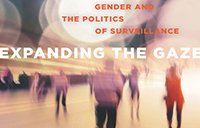Expanding the Gaze: Gender and the Politics of Surveillance portrays the ways in which surveillance – whether repressive, resilient, resistant or enjoyable – is shaped around gender.

This group of essays is co-edited by York University’s communication studies Professor Robert Heynen and Ryerson University’s criminology Professor Emily van der Meulen.
“The book engages with a wide range of surveillance practices, from social media to state surveillance,” says Heynen. “The contributors all argue in different ways that gender plays a key role in how systems of surveillance have developed, and what their implications are for our everyday lives. These implications are complex, in some cases reinforcing or deepening forms of gender inequity, in others enabling challenges to those inequities.”
The ways in which surveillance is gendered depends on context. Heynen offers the example of how gender is the first question asked on birth certificates and social media profiles as a form of identification and surveillance.
“The significance of a gendered perspective can be seen in the chapter in our book by Zoë Newman, who teaches in sociology, and gender and women’s studies, at York University,” says Heynen, who explains Newman looks at how police and state surveillance, as well as media coverage, targeted gay men in Toronto in the 1970s as part of broader ways in which the downtown was being reshaped.
“In this case, dominant conceptions of gender, sexuality and race were embedded in the systems of surveillance that were implemented in the city, with often very damaging implications for gay men,” says Heynen. “The book as a whole suggests that we will fundamentally misunderstand the dynamics of surveillance unless we take gender into account, including the ways in which gender interacts with other forms of subjectivity, like race, disability, sexuality and class.”
 Examples of contemporary surveillance include the familiar – CCTV cameras, border security systems – and the more covert.
Examples of contemporary surveillance include the familiar – CCTV cameras, border security systems – and the more covert.
“Thanks to Edward Snowden and WikiLeaks, we are now also painfully aware of the extent to which governments and corporations collect data about us at every turn,” says Heynen. “Everything from social media platforms to medical systems are built around the collection of data, increasingly in digitized and automated forms. In other words, almost every aspect of our lives is shaped one way or another by systems of surveillance.”
The book’s contributing authors hail from Canada, the United States, the United Kingdom and Australia. They are a mix of established and emerging researchers from a variety of fields, including communication studies, criminology, sociology, law, nursing, health and women’s studies. The book’s interdisciplinary and accessible approach makes it suitable for scholars from undergraduate to advanced researchers.
Heynen and van der Meulen co-wrote chapter one, “Gendered Visions: Reimagining Surveillance Studies,” which sets the context for the rest of the book.
“Research in the field has not adequately engaged with the question of gender, and we analyze the problems that result,” says Heynen. “Given the rapid growth of the field, and in the scope of surveillance itself, this is a significant concern.”


